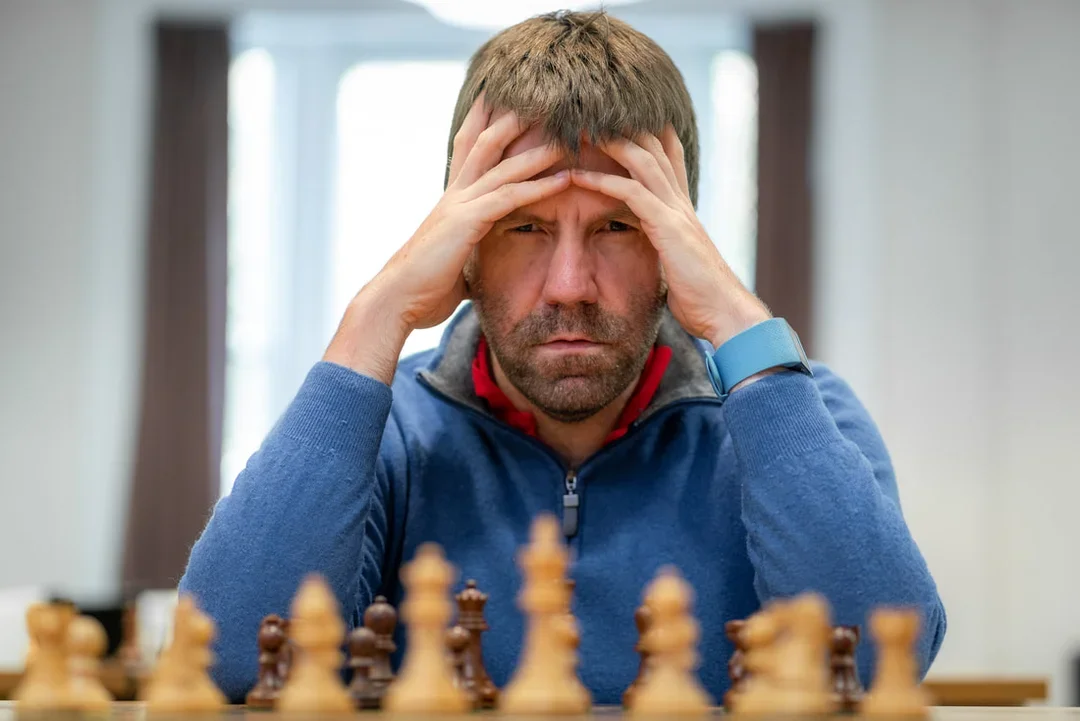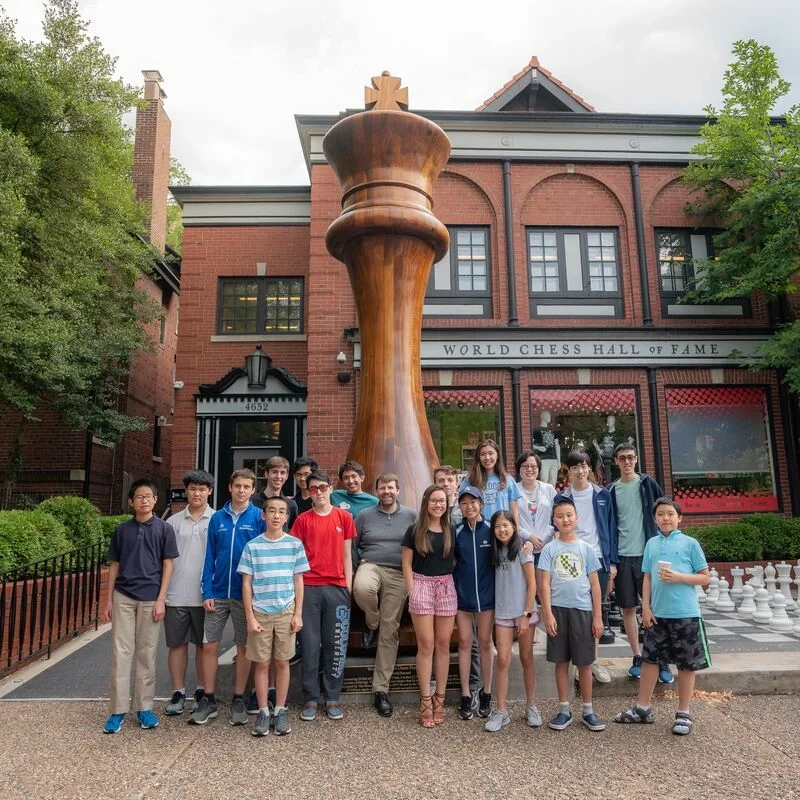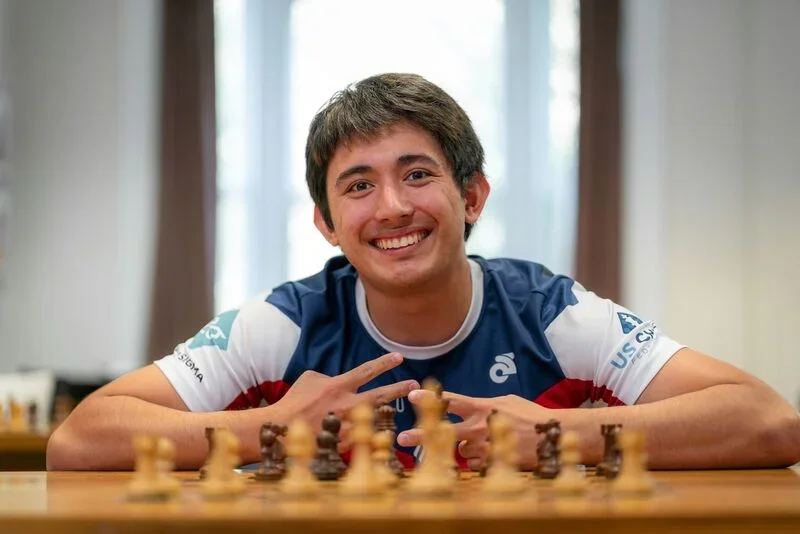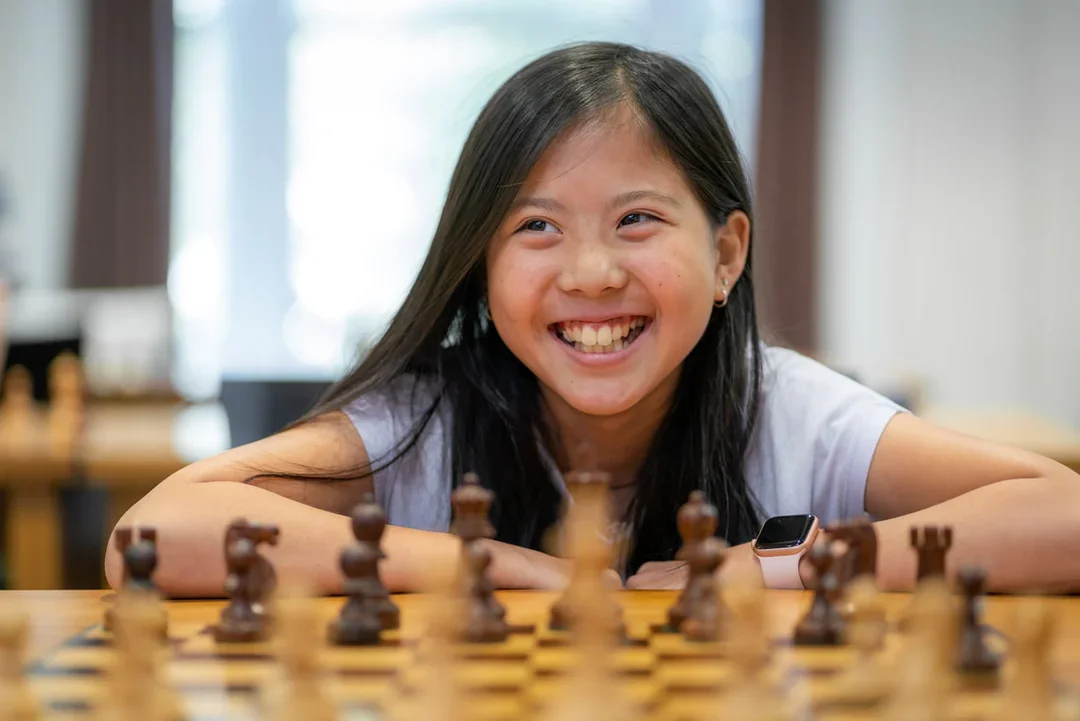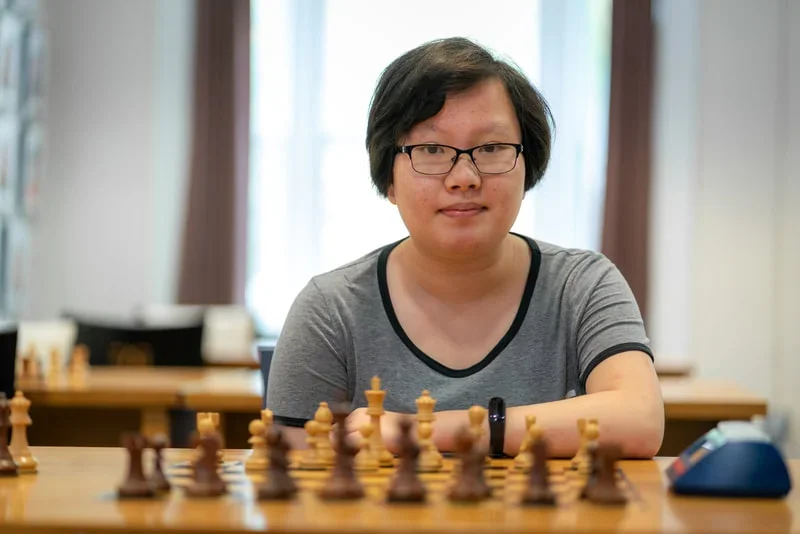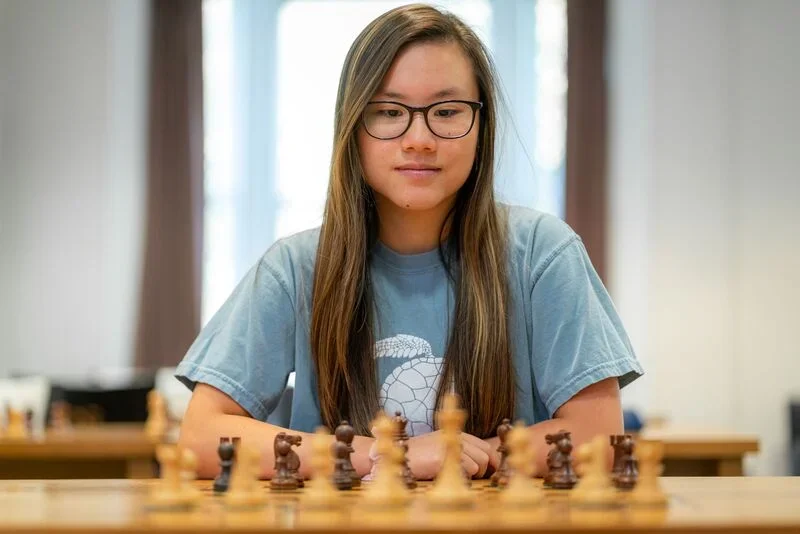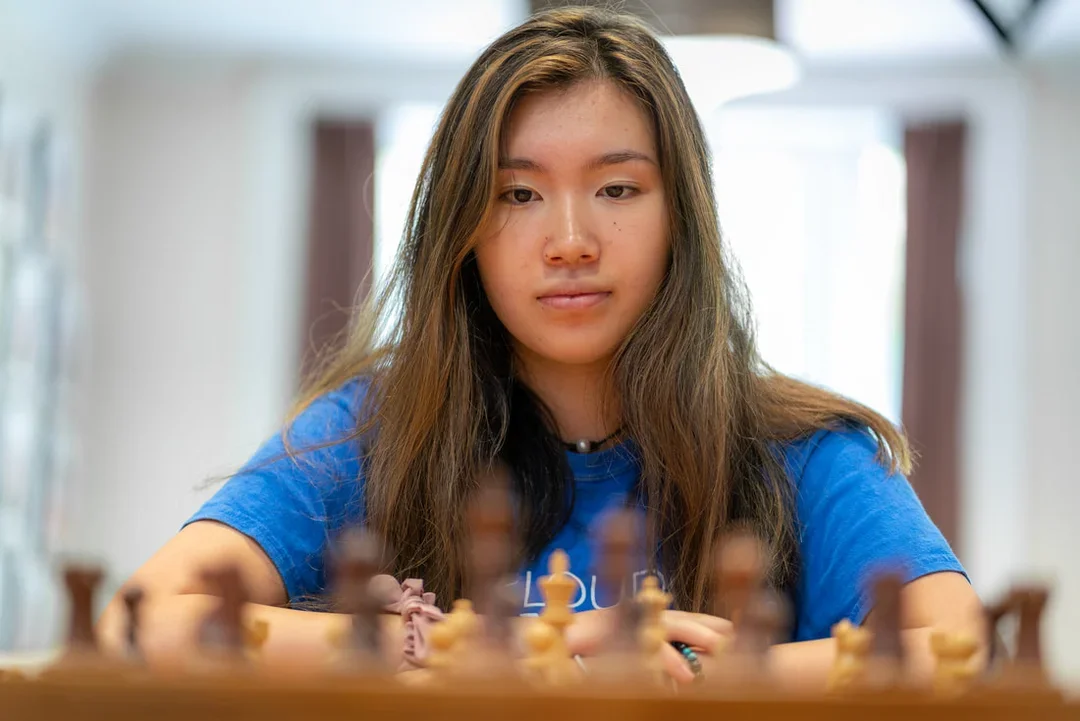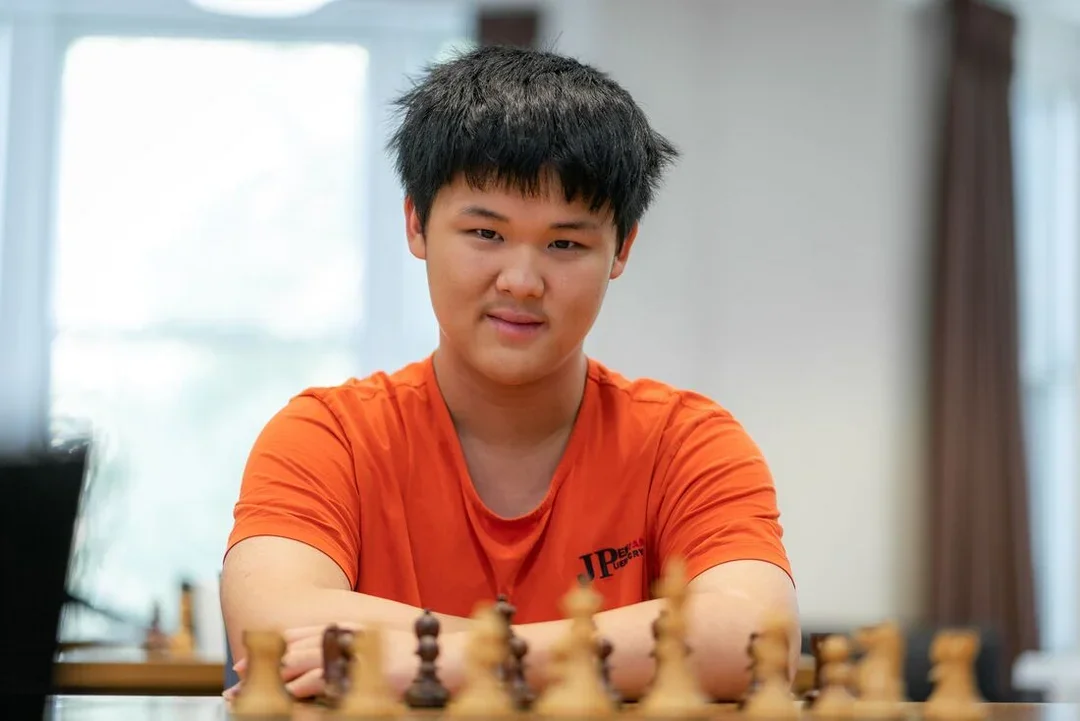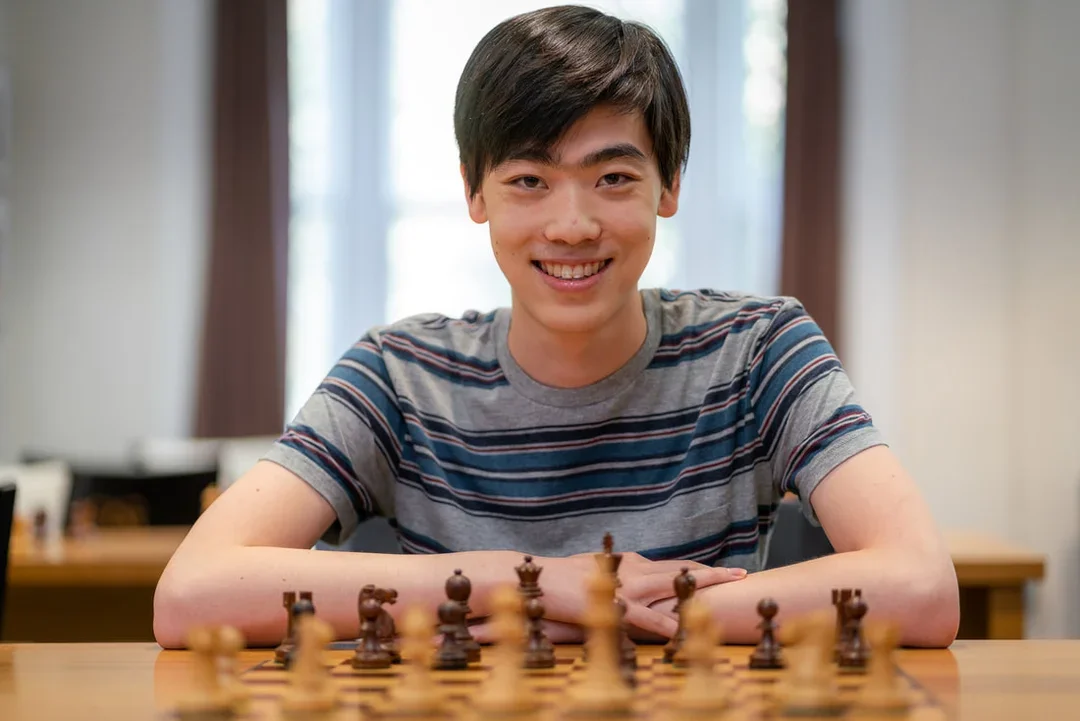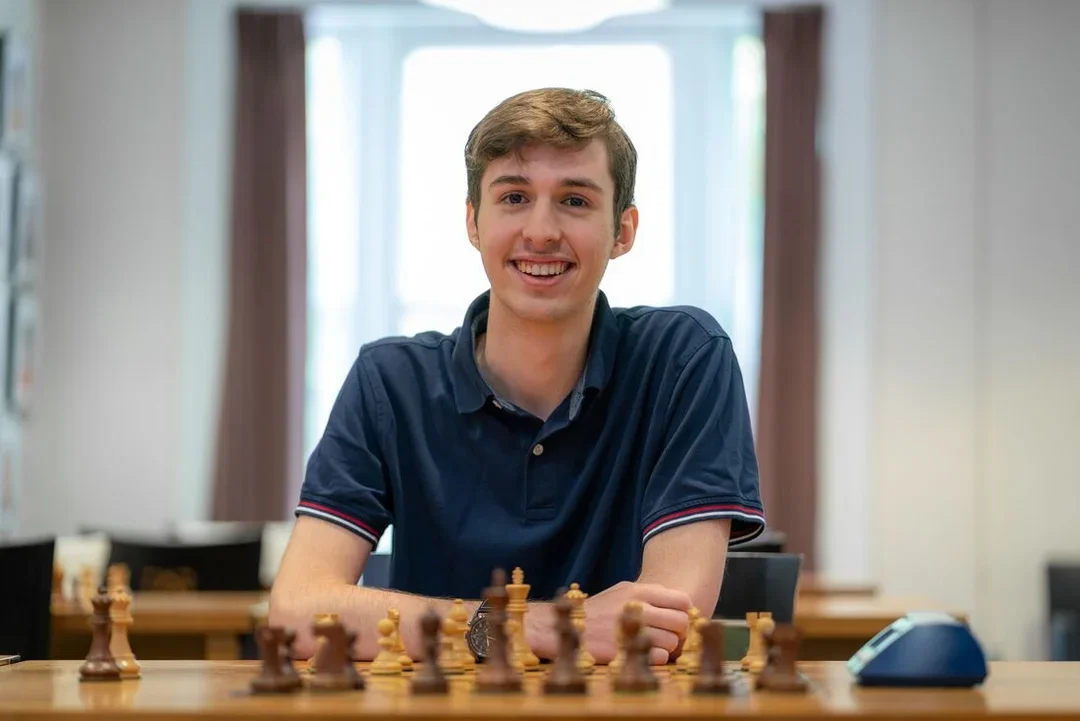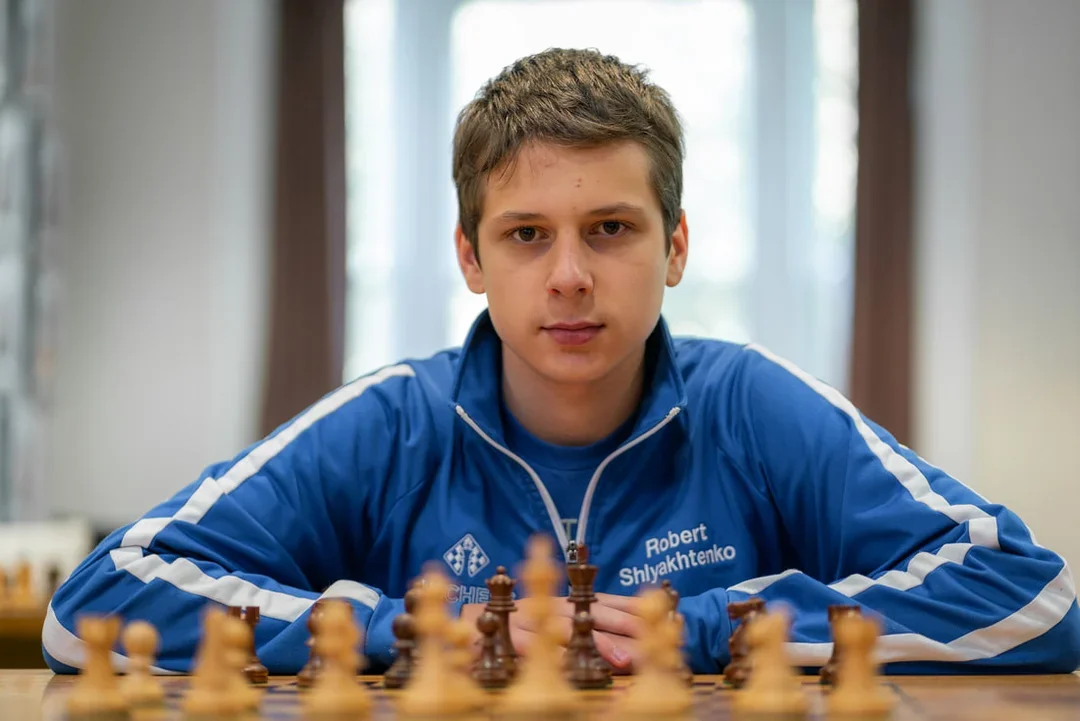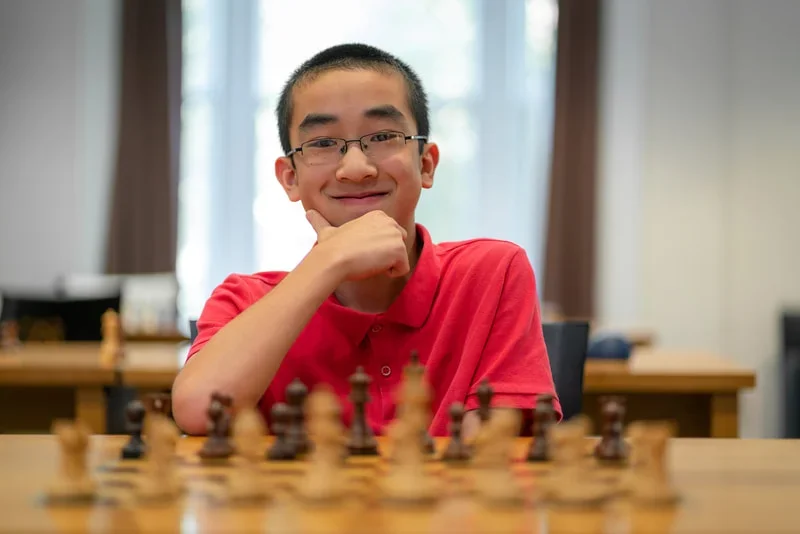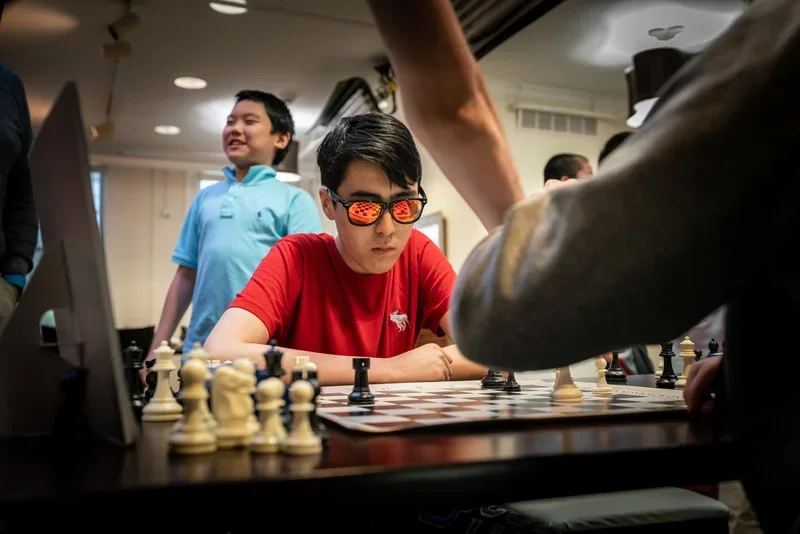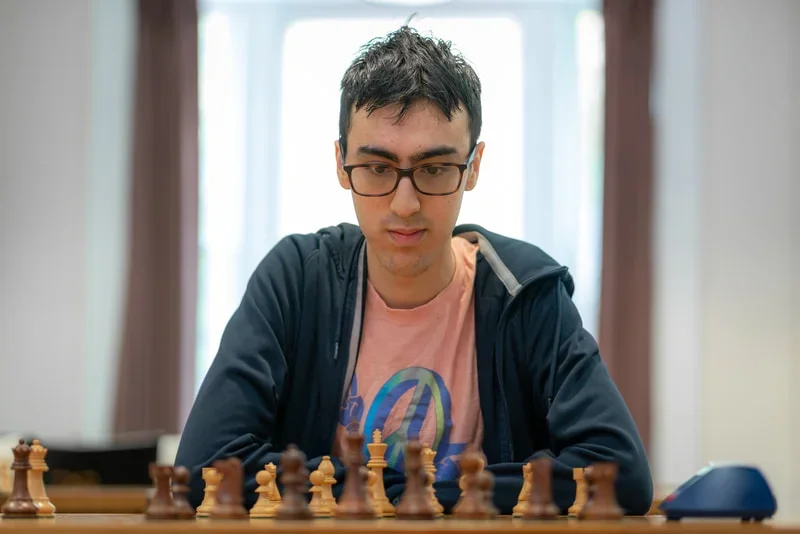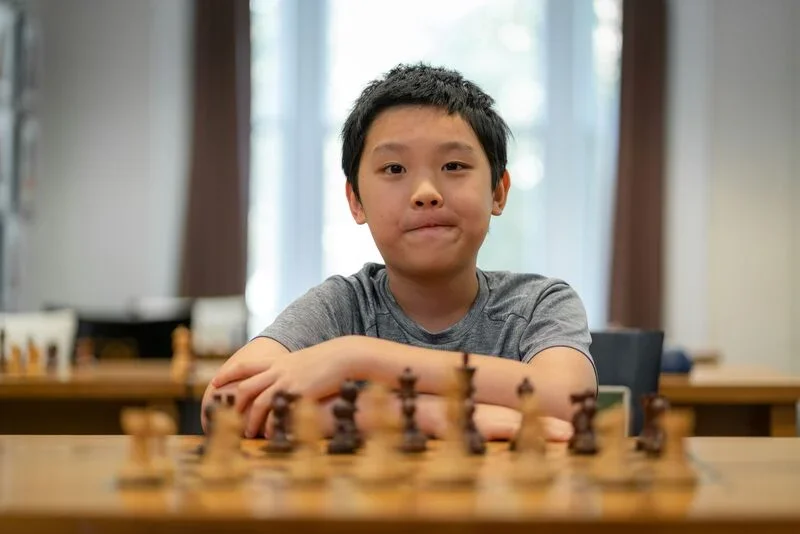This is the third of a four-part series, “Back to the US Chess School”, which gives readers an inside look into the elite training academies, held over the summer. Check out our first installment by Jed Sloan on USCS #48 in Saint Louis, our second installment by Davis Zong Jr on USCS #49 in New York, and look for an upcoming edition by Akira Nakada on #51. Also look for additional perspective on the Aagaard camp by CLO editor John Hartmann.
At a high level, it is not at all uncommon for chess players to be at least somewhat paranoid about their peers. Even the closest friends inevitably sit across the board from each other as fierce competitors. At the very least, one has to be on guard about not accidentally giving away opening prep or losing focus by talking to friends too much, raising the tension.
This is why I’ve always loved US Chess Schools. The atmosphere transforms into one of friendly camaraderie: perfect for blitz, bughouse, and nerdy chess inside jokes. For me, attending the US Chess School is about creating fun memories while improving at the game I love most. It’s a great opportunity to spend a week with some of my closest chess pals while learning chess from amazing trainers – and in the case of the US Chess School 50 specifically, one of the best chess trainers in the world.
I’d been gobbling up many of GM Jacob Aagaard’s books since I was 12, captivated by his humorous writing style and never-ending supply of rich positions. He walked in on the first day of camp looking a bit disoriented, set down his bag, and immediately began spilling an animated narrative about how the idiots at the airport lost all of his luggage. Soon after, we had a fun group discussion titled “What is wrong with Anish Giri?!?!” We looked at a few games where Giri’s strategic, positional, and technical play was flawless, but he was simply unable to calculate a few forced moves to finish off the game. Hence, the joke “Anish Giri can’t calculate!” emerged. Everyone cracked at least a smile. Aagaard was certainly strict and kept us in line, but it was balanced with the right amount of humor and jest. Thus set the mood for our five days of training with one of the world’s greatest chess trainers.
Throughout the week, we looked at a plethora of different positions and discussed many chess concepts and ideas in different contexts. But Aagaard made extra sure to hammer two general guidelines into our heads, and every participant at the camp could tell you by heart what they were. #1: Always actively look for each and every option in a position. Most deep calculation errors happen not on move 10 of a long variation, but on move 1 or 2 of the variation where the player simply overlooked something major. The same holds true for major positional and strategic errors in many top level games. #2: Always have a plan for your ****** pieces!!! (exact words straight out of Aagaard’s mouth.) This one is so simple, yet so easy to neglect and forget about during a game! It is largely about improving your worst placed piece, but many times it is also about rerouting a piece on a good square to an even better one.
Here’s one of the puzzles from the camp:
White is up a pawn, and although Black might at first dream about winning chances because White’s bishop is close to trapped, we soon realize that Black is playing to draw.
Black to Move
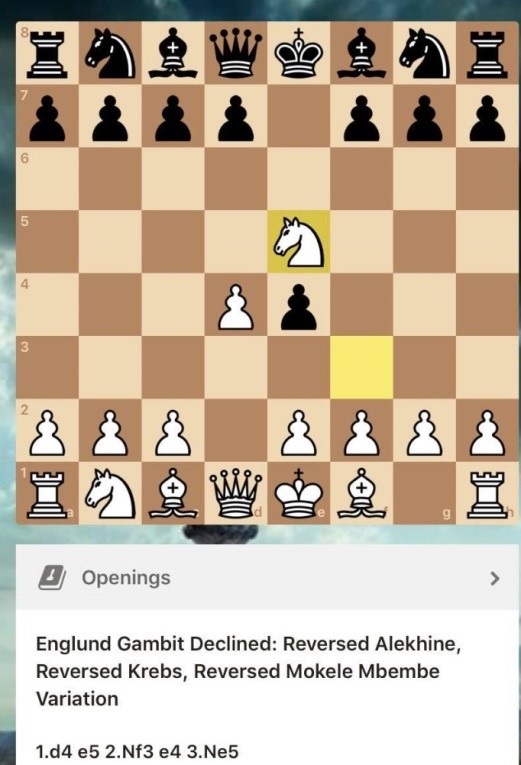 A few minutes of nonstop laughter later, the Englund Gambit Declined: Reversed Alekhine, Reversed Krebs, Reversed Mokele Mbembe Variation became all the rage. In the camp bullet tournament, this troll opening was played no less than fivwe times. I laughed for minutes when I discovered that 3…f6 could be soundly met by 4.e3!?.
Special guests is another incredible feature of US Chess School camps, especially in Saint Louis. When Grandmaster Peter Svidler appeared at camp on the last day, we asked him many burning questions, including "how are you so tall?", "What is your favorite ice cream flavor?", and "What is your opinion on the Englund Gambit Declined: Reversed Alekhine, Reversed Krebs, Reversed Mokele Mbembe Variation?" I’m supposedly a mature 19 year-old, but I’ll admit I giggled like a 10 year old when I saw the perplexed look on the face of the eight-time Russian champion and renowned commentator.
https://twitter.com/USChessSchool/status/1154782518098481152
Another silly question for Svidler is also a legitimate brainteaser."What is the third worse move against the Dutch?" The worst move is clearly 2.Bh6 and the second worst move is definitely 2.Kd2. But what’s the third? A few years ago in 2015, Jan Gustafsson claimed 2.e4 was worst, implying that the Staunton Gambit is terrible and just gives away a pawn. Aagaard and Svidler both disagreed, suggesting 2.Na3 and 2.b4 respectively.
A few minutes of nonstop laughter later, the Englund Gambit Declined: Reversed Alekhine, Reversed Krebs, Reversed Mokele Mbembe Variation became all the rage. In the camp bullet tournament, this troll opening was played no less than fivwe times. I laughed for minutes when I discovered that 3…f6 could be soundly met by 4.e3!?.
Special guests is another incredible feature of US Chess School camps, especially in Saint Louis. When Grandmaster Peter Svidler appeared at camp on the last day, we asked him many burning questions, including "how are you so tall?", "What is your favorite ice cream flavor?", and "What is your opinion on the Englund Gambit Declined: Reversed Alekhine, Reversed Krebs, Reversed Mokele Mbembe Variation?" I’m supposedly a mature 19 year-old, but I’ll admit I giggled like a 10 year old when I saw the perplexed look on the face of the eight-time Russian champion and renowned commentator.
https://twitter.com/USChessSchool/status/1154782518098481152
Another silly question for Svidler is also a legitimate brainteaser."What is the third worse move against the Dutch?" The worst move is clearly 2.Bh6 and the second worst move is definitely 2.Kd2. But what’s the third? A few years ago in 2015, Jan Gustafsson claimed 2.e4 was worst, implying that the Staunton Gambit is terrible and just gives away a pawn. Aagaard and Svidler both disagreed, suggesting 2.Na3 and 2.b4 respectively.
 Apparently, Stockfish 9 on a relatively low depth thinks 2.Qd2 and 2.f3 are equally bad. It’s still not worse for White though, which may or may not say something about the Dutch as an opening.
However, 2.e4 is the worst move after that, meaning Jan Gustafsson was closest to the truth!
Apparently, Stockfish 9 on a relatively low depth thinks 2.Qd2 and 2.f3 are equally bad. It’s still not worse for White though, which may or may not say something about the Dutch as an opening.
However, 2.e4 is the worst move after that, meaning Jan Gustafsson was closest to the truth!
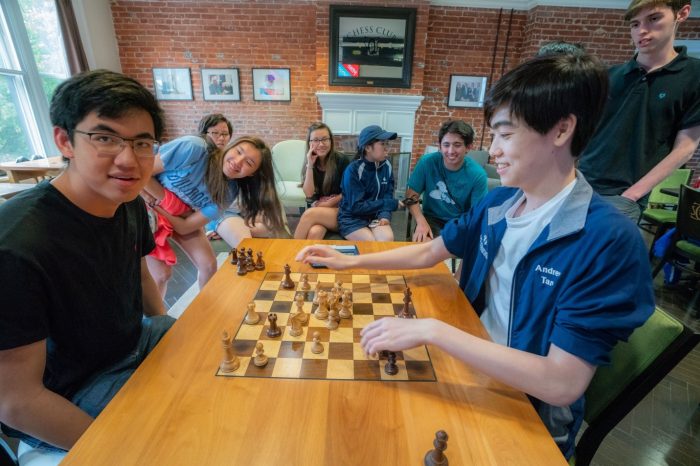 Joshua Sheng and Andrew Tang smile after their intense bullet matchup in the notorious Englund Gambit Declined: Reversed Alekhine, Reversed Krebs, Reversed Mokele Mbembe Variation. Carissa Yip with my sunglasses (in her right hand) while I purposefully ignore her antics.Also pictured; Maggie Feng, Jennifer Yu, Emily Nguyen and Nicholas Checa
Overall, I had an overwhelmingly positive experience at the USCS 50 and beyond GM Aagard, I want to thank our sponsor Dr. Jim Roberts, organizer IM Greg Shahade and hosts at the Saint Louis Chess Club. I truly feel like I picked up some valuable chess wisdom, and enjoyed myself immensely throughout the process.
Check out our first installment on USCS summer of 2019 camps by Jed Sloan on USCS #48 in Saint Louis, our second installment by Davis Zong Jr on USCS #49 in New York, and look for an upcoming edition by Akira Nakada on #51.
Find GM Aagaard's books on US Chess Sales and stay up to date with the US Chess School on their website and twitter.
Follow article photographer IM Eric Rosen on his website and twitch.
Joshua Sheng and Andrew Tang smile after their intense bullet matchup in the notorious Englund Gambit Declined: Reversed Alekhine, Reversed Krebs, Reversed Mokele Mbembe Variation. Carissa Yip with my sunglasses (in her right hand) while I purposefully ignore her antics.Also pictured; Maggie Feng, Jennifer Yu, Emily Nguyen and Nicholas Checa
Overall, I had an overwhelmingly positive experience at the USCS 50 and beyond GM Aagard, I want to thank our sponsor Dr. Jim Roberts, organizer IM Greg Shahade and hosts at the Saint Louis Chess Club. I truly feel like I picked up some valuable chess wisdom, and enjoyed myself immensely throughout the process.
Check out our first installment on USCS summer of 2019 camps by Jed Sloan on USCS #48 in Saint Louis, our second installment by Davis Zong Jr on USCS #49 in New York, and look for an upcoming edition by Akira Nakada on #51.
Find GM Aagaard's books on US Chess Sales and stay up to date with the US Chess School on their website and twitter.
Follow article photographer IM Eric Rosen on his website and twitch.
Surprisingly Black can send his king away from the passed pawn with 1…Kf6! and White has no way to stop 2…Kg7 3.Bxe6 Kf6 with a repetition.
Of course, there are also the inside jokes. One evening when I was hanging with Joshua Sheng, Aaron Jacobson, and Andrew Tang, Andrew (penguingm) was playing a bullet game on his phone and reached the following position:
 A few minutes of nonstop laughter later, the Englund Gambit Declined: Reversed Alekhine, Reversed Krebs, Reversed Mokele Mbembe Variation became all the rage. In the camp bullet tournament, this troll opening was played no less than fivwe times. I laughed for minutes when I discovered that 3…f6 could be soundly met by 4.e3!?.
Special guests is another incredible feature of US Chess School camps, especially in Saint Louis. When Grandmaster Peter Svidler appeared at camp on the last day, we asked him many burning questions, including "how are you so tall?", "What is your favorite ice cream flavor?", and "What is your opinion on the Englund Gambit Declined: Reversed Alekhine, Reversed Krebs, Reversed Mokele Mbembe Variation?" I’m supposedly a mature 19 year-old, but I’ll admit I giggled like a 10 year old when I saw the perplexed look on the face of the eight-time Russian champion and renowned commentator.
https://twitter.com/USChessSchool/status/1154782518098481152
Another silly question for Svidler is also a legitimate brainteaser."What is the third worse move against the Dutch?" The worst move is clearly 2.Bh6 and the second worst move is definitely 2.Kd2. But what’s the third? A few years ago in 2015, Jan Gustafsson claimed 2.e4 was worst, implying that the Staunton Gambit is terrible and just gives away a pawn. Aagaard and Svidler both disagreed, suggesting 2.Na3 and 2.b4 respectively.
A few minutes of nonstop laughter later, the Englund Gambit Declined: Reversed Alekhine, Reversed Krebs, Reversed Mokele Mbembe Variation became all the rage. In the camp bullet tournament, this troll opening was played no less than fivwe times. I laughed for minutes when I discovered that 3…f6 could be soundly met by 4.e3!?.
Special guests is another incredible feature of US Chess School camps, especially in Saint Louis. When Grandmaster Peter Svidler appeared at camp on the last day, we asked him many burning questions, including "how are you so tall?", "What is your favorite ice cream flavor?", and "What is your opinion on the Englund Gambit Declined: Reversed Alekhine, Reversed Krebs, Reversed Mokele Mbembe Variation?" I’m supposedly a mature 19 year-old, but I’ll admit I giggled like a 10 year old when I saw the perplexed look on the face of the eight-time Russian champion and renowned commentator.
https://twitter.com/USChessSchool/status/1154782518098481152
Another silly question for Svidler is also a legitimate brainteaser."What is the third worse move against the Dutch?" The worst move is clearly 2.Bh6 and the second worst move is definitely 2.Kd2. But what’s the third? A few years ago in 2015, Jan Gustafsson claimed 2.e4 was worst, implying that the Staunton Gambit is terrible and just gives away a pawn. Aagaard and Svidler both disagreed, suggesting 2.Na3 and 2.b4 respectively.
 Apparently, Stockfish 9 on a relatively low depth thinks 2.Qd2 and 2.f3 are equally bad. It’s still not worse for White though, which may or may not say something about the Dutch as an opening.
However, 2.e4 is the worst move after that, meaning Jan Gustafsson was closest to the truth!
Apparently, Stockfish 9 on a relatively low depth thinks 2.Qd2 and 2.f3 are equally bad. It’s still not worse for White though, which may or may not say something about the Dutch as an opening.
However, 2.e4 is the worst move after that, meaning Jan Gustafsson was closest to the truth!
 Joshua Sheng and Andrew Tang smile after their intense bullet matchup in the notorious Englund Gambit Declined: Reversed Alekhine, Reversed Krebs, Reversed Mokele Mbembe Variation. Carissa Yip with my sunglasses (in her right hand) while I purposefully ignore her antics.Also pictured; Maggie Feng, Jennifer Yu, Emily Nguyen and Nicholas Checa
Joshua Sheng and Andrew Tang smile after their intense bullet matchup in the notorious Englund Gambit Declined: Reversed Alekhine, Reversed Krebs, Reversed Mokele Mbembe Variation. Carissa Yip with my sunglasses (in her right hand) while I purposefully ignore her antics.Also pictured; Maggie Feng, Jennifer Yu, Emily Nguyen and Nicholas ChecaCategories
Archives
- December 2025 (26)
- November 2025 (29)
- October 2025 (39)
- September 2025 (27)
- August 2025 (29)
- July 2025 (43)
- June 2025 (25)
- May 2025 (24)
- April 2025 (29)
- March 2025 (29)
- February 2025 (20)
- January 2025 (24)
- December 2024 (34)
- November 2024 (18)
- October 2024 (35)
- September 2024 (23)
- August 2024 (27)
- July 2024 (44)
- June 2024 (27)
- May 2024 (31)
- April 2024 (51)
- March 2024 (34)
- February 2024 (25)
- January 2024 (26)
- December 2023 (29)
- November 2023 (26)
- October 2023 (37)
- September 2023 (27)
- August 2023 (37)
- July 2023 (47)
- June 2023 (33)
- May 2023 (37)
- April 2023 (45)
- March 2023 (37)
- February 2023 (28)
- January 2023 (31)
- December 2022 (23)
- November 2022 (32)
- October 2022 (31)
- September 2022 (19)
- August 2022 (39)
- July 2022 (32)
- June 2022 (35)
- May 2022 (21)
- April 2022 (31)
- March 2022 (33)
- February 2022 (21)
- January 2022 (27)
- December 2021 (36)
- November 2021 (34)
- October 2021 (25)
- September 2021 (25)
- August 2021 (41)
- July 2021 (36)
- June 2021 (29)
- May 2021 (29)
- April 2021 (31)
- March 2021 (33)
- February 2021 (28)
- January 2021 (29)
- December 2020 (38)
- November 2020 (40)
- October 2020 (41)
- September 2020 (35)
- August 2020 (38)
- July 2020 (36)
- June 2020 (46)
- May 2020 (42)
- April 2020 (37)
- March 2020 (60)
- February 2020 (38)
- January 2020 (45)
- December 2019 (34)
- November 2019 (35)
- October 2019 (42)
- September 2019 (45)
- August 2019 (56)
- July 2019 (44)
- June 2019 (35)
- May 2019 (40)
- April 2019 (48)
- March 2019 (61)
- February 2019 (39)
- January 2019 (30)
- December 2018 (29)
- November 2018 (51)
- October 2018 (45)
- September 2018 (29)
- August 2018 (49)
- July 2018 (35)
- June 2018 (31)
- May 2018 (39)
- April 2018 (31)
- March 2018 (26)
- February 2018 (33)
- January 2018 (30)
- December 2017 (26)
- November 2017 (24)
- October 2017 (30)
- September 2017 (30)
- August 2017 (31)
- July 2017 (28)
- June 2017 (32)
- May 2017 (26)
- April 2017 (37)
- March 2017 (28)
- February 2017 (30)
- January 2017 (27)
- December 2016 (29)
- November 2016 (24)
- October 2016 (32)
- September 2016 (31)
- August 2016 (27)
- July 2016 (24)
- June 2016 (26)
- May 2016 (19)
- April 2016 (30)
- March 2016 (36)
- February 2016 (28)
- January 2016 (32)
- December 2015 (26)
- November 2015 (23)
- October 2015 (16)
- September 2015 (28)
- August 2015 (28)
- July 2015 (6)
- June 2015 (1)
- May 2015 (2)
- April 2015 (1)
- February 2015 (3)
- January 2015 (1)
- December 2014 (1)
- July 2010 (1)
- October 1991 (1)
- August 1989 (1)
- January 1988 (1)
- December 1983 (1)


